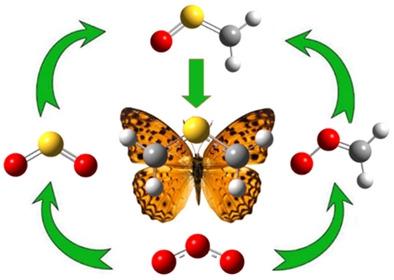当前位置:
X-MOL 学术
›
J. Comput. Chem.
›
论文详情
Our official English website, www.x-mol.net, welcomes your feedback! (Note: you will need to create a separate account there.)
Dipolar 1,3-cycloaddition of thioformaldehyde S-methylide (CH2SCH2) to ethylene and acetylene. A comparison with (valence) isoelectronic O3, SO2, CH2OO and CH2SO
Journal of Computational Chemistry ( IF 3 ) Pub Date : 2022-06-06 , DOI: 10.1002/jcc.26946 Zoi Salta 1 , Mauricio Vega-Teijido 2 , Aline Katz 2 , Nicola Tasinato 1 , Vincenzo Barone 1 , Oscar N Ventura 2
Journal of Computational Chemistry ( IF 3 ) Pub Date : 2022-06-06 , DOI: 10.1002/jcc.26946 Zoi Salta 1 , Mauricio Vega-Teijido 2 , Aline Katz 2 , Nicola Tasinato 1 , Vincenzo Barone 1 , Oscar N Ventura 2
Affiliation

|
Methods rooted in the density functional theory and in the coupled cluster ansatz were employed to investigate the cycloaddition reactions to ethylene and acetylene of 1,3-dipolar species including ozone and the derivatives issued from replacement of the central oxygen atom by the valence-isoelectronic sulfur atom, and/or of one or both terminal oxygen atoms by the isoelectronic CH2 group. This gives rise to five different 1,3-dipolar compounds, namely ozone itself (O3), sulfur dioxide (SO2), the simplest Criegee intermediate (CH2OO), sulfine (CH2SO), and thioformaldehyde S-methylide (CH2SCH2, TSM). The experimental and accurate theoretical data available for some of those molecules were employed to assess the accuracy of two last-generation composite methods employing conventional or explicitly correlated post-Hartree-Fock contributions (jun-Cheap and SVECV-f12, respectively), which were then applied to investigate the reactivity of TSM. The energy barriers provided by both composite methods are very close (the average values for the two composite methods are 7.1 and 8.3 kcal mol−1 for the addition to ethylene and acetylene, respectively) and comparable to those ruling the corresponding additions of ozone (4.0 and 7.7 kcal mol−1, respectively). These and other evidences strongly suggest that, at least in the case of cycloadditions, the reactivity of TSM is similar to that of O3 and very different from that of SO2.
中文翻译:

硫代甲醛 S-甲基 (CH2SCH2) 与乙烯和乙炔的偶极 1,3-环加成。与(价)等电子 O3、SO2、CH2OO 和 CH2SO 的比较
采用基于密度泛函理论和耦合簇 ansatz 的方法研究了 1,3-偶极物质(包括臭氧)和由价等电子硫取代中心氧原子产生的衍生物与乙烯和乙炔的环加成反应原子,和/或一个或两个末端氧原子的等电子CH 2基团。这产生了五种不同的 1,3-偶极化合物,即臭氧本身 (O 3 )、二氧化硫 (SO 2 )、最简单的 Criegee 中间体 (CH 2 OO)、亚磺酸 (CH 2 SO) 和硫代甲醛S-甲基化物(CH 2 SCH 2,TSM)。其中一些分子可用的实验和准确理论数据被用来评估两种最后一代复合方法的准确性,这些方法采用常规或明确相关的 Hartree-Fock 后贡献(分别为 jun-Cheap 和 SVECV-f12),它们是然后应用于研究 TSM 的反应性。两种复合方法提供的能垒非常接近(两种复合方法的平均值分别为乙烯和乙炔加成的 7.1 和 8.3 kcal mol -1),并且与相应的臭氧添加(4.0和 7.7 kcal mol -1, 分别)。这些和其他证据强烈表明,至少在环加成的情况下,TSM 的反应性与 O 3的反应性相似,而与 SO 2的反应性非常不同。
更新日期:2022-06-06
中文翻译:

硫代甲醛 S-甲基 (CH2SCH2) 与乙烯和乙炔的偶极 1,3-环加成。与(价)等电子 O3、SO2、CH2OO 和 CH2SO 的比较
采用基于密度泛函理论和耦合簇 ansatz 的方法研究了 1,3-偶极物质(包括臭氧)和由价等电子硫取代中心氧原子产生的衍生物与乙烯和乙炔的环加成反应原子,和/或一个或两个末端氧原子的等电子CH 2基团。这产生了五种不同的 1,3-偶极化合物,即臭氧本身 (O 3 )、二氧化硫 (SO 2 )、最简单的 Criegee 中间体 (CH 2 OO)、亚磺酸 (CH 2 SO) 和硫代甲醛S-甲基化物(CH 2 SCH 2,TSM)。其中一些分子可用的实验和准确理论数据被用来评估两种最后一代复合方法的准确性,这些方法采用常规或明确相关的 Hartree-Fock 后贡献(分别为 jun-Cheap 和 SVECV-f12),它们是然后应用于研究 TSM 的反应性。两种复合方法提供的能垒非常接近(两种复合方法的平均值分别为乙烯和乙炔加成的 7.1 和 8.3 kcal mol -1),并且与相应的臭氧添加(4.0和 7.7 kcal mol -1, 分别)。这些和其他证据强烈表明,至少在环加成的情况下,TSM 的反应性与 O 3的反应性相似,而与 SO 2的反应性非常不同。



























 京公网安备 11010802027423号
京公网安备 11010802027423号